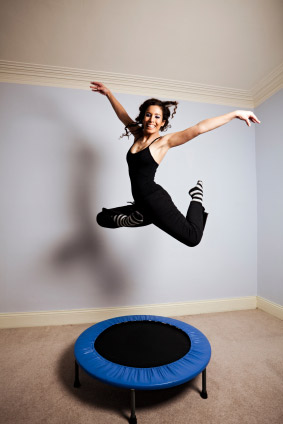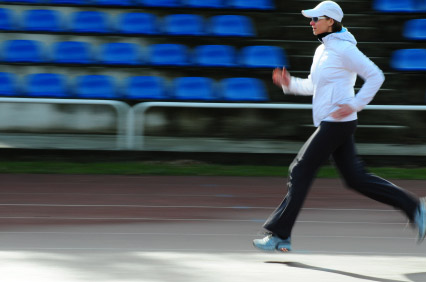 |
 |
|
 Mini-trampoline exercising, or rebounding, is a fun and
low-impact way to stay fit. At home or at the gym, this fitness prop is a
well-rounded asset to your workout routine, as it provides an often-overlooked
assortment of benefits! Mini-trampoline exercising, or rebounding, is a fun and
low-impact way to stay fit. At home or at the gym, this fitness prop is a
well-rounded asset to your workout routine, as it provides an often-overlooked
assortment of benefits!
Aside from being fun, mini-trampolines give you a full-body
aerobic exercise that also improves overall muscle tone- particularly in your
calves, quads and glutes! Even your core abdominals and back muscles will get a
good workout from all that jumping!
Mini-trampolines, because of their spring-loaded bounce, are
very low impact on your joints, so it's great for all ages and fitness levels. Whereas
many other types of aerobic workouts stress knees, hips and shins; trampolines
provide you with enough cushion that your knees barely notice you are jumping.
Try that on pavement!
There's even some health bonuses to using mini-trampolines.
Mini trampoline exercise increases the lymphatic system function, which is the
system that controls the body's detoxification by carrying away toxins from the
cells. So bouncing on a mini trampoline rids the body of toxins such as dead cells,
fat, infections, viruses, nitrogenous wastes, heavy metals, and other toxins - and is a great work out!
|
|
 |
 |
 Looking for a way to
stay in shape that's not so hard on your joints? Try walking. Walking improves
aerobic fitness, increases the body's cardiovascular capacity, and your lung
power. Walking is one of the safest workouts for your body, and is still
effective enough to help you shed any unwanted pounds, or get started on your
journey towards a healthy lifestyle. Looking for a way to
stay in shape that's not so hard on your joints? Try walking. Walking improves
aerobic fitness, increases the body's cardiovascular capacity, and your lung
power. Walking is one of the safest workouts for your body, and is still
effective enough to help you shed any unwanted pounds, or get started on your
journey towards a healthy lifestyle.
Walking is more versatile
than ever with the help of a treadmill. By using a treadmill in the secure environment
of the gym, you can control and vary the pace, resistance, or incline - which
allows you to gradually increase endurance as well as strength in your thighs, calves
and glutes.
To get started, walk
at a comfortable pace for 5-10 minutes. Start increasing your pace so that you are
walking at a pace that brings your heart rate up to 70-80% of your maximum
heart rate. This pace will feel fast, and you will start to breathe harder. At this
point, you should not be able to carry on a regular conversation, but you
should still be able to speak in short sentences. Walk at this pace for 30-50
minutes. If you are new to exercise, then start with 15 minutes, working your
way up to 30 minutes within a few weeks.
You should follow this
quick pace with a cool-down walk - at least 5 minutes, slowing back down to the
easy pace. Gradually step down your cool off period. You can continue to walk at your easy pace
for another 5 minutes.
Walking is a simple
and easy way for many people to get the recommended level of exercise. Be sure
to talk to your doctor before beginning any new fitness routine.
|
|
 |
 |
 Something
about a 20 minute workout having the same impact as a typical long winded
session at the gym really appeals to many. Fast fitness that targets all the
major muscle groups, makes you sweat, torches tons of calories, boosts the body's
overall metabolic rate, and still leaves time for a shower? Where do you sign
up? I'm talking, of course, about HIIT: High Intensity Interval Training. Something
about a 20 minute workout having the same impact as a typical long winded
session at the gym really appeals to many. Fast fitness that targets all the
major muscle groups, makes you sweat, torches tons of calories, boosts the body's
overall metabolic rate, and still leaves time for a shower? Where do you sign
up? I'm talking, of course, about HIIT: High Intensity Interval Training.
How does this miraculous sounding workout get powerful results? The answer is in the science behind it all. The
goal of HIIT is to hold an anaerobic state over an accumulated amount of time.
It's designed with rest intervals to allow you to do longer and harder bursts
during your workout. For example, if you were to sprint for 100
meters, you would go full out for about 15 seconds (depending how fast you
were). Compare this to a HIIT workout: 5 minutes is generally spent with warm
up and cool down (essential for preventing injuries & not over-working your
heart!), and 15 is spent with the workout. Of the 15, 4-8 minutes will be spent
in those bursts or sprints - depending on your fitness level.
Here are some basic tips to get you
started with your HIIT:
- It's intense! You will
zap more calories during the workout, and it will increase your metabolic rate.
Be sure to eat about ½ an hour before your workout - something light and
energizing!
- Take a break! HIIT
should only be done every other day at the most. Doing HIIT every day will
overtax your body. It works best for burning calories and
increasing strength when your body has a day between workouts to rebuild.
- Try something new! There are a variety of workouts you can do with HIIT. The point is to incorporate
intervals. The most effective is jogging with sprints, but you can try
intervals on the bike, elliptical machine, jumping rope, swimming, and more.
- Mix it up! The point
of high intensity interval training is to avoid plateaus and keep your body
on its toes. Sticking to one HIIT routine will bore your body and start to
decrease its effectiveness. Mix up the pace or interval of your bursts, or
switch the type of workout you do your intervals with.
- Raise your heart
rate. To be effectively doing HIIT, you want your heart rate at or above 80% of
its maximum rate during your bursts. The regular periods should be a jogging
pace.
High intensity interval training is sure to be a challenge to anyone, and will definitely
give you the results you want in no time at all - while leaving you plenty of
room for all the other things in your life!
|
|
 |
 |
Pilates
is a workout that consists of physical conditioning with benefits of
increased flexibility, strength without the bulk, and endurance, as
well as mental benefits such as increased mental acuity,
concentration, and pain tolerance. Pilates works all muscle groups, but
in
almost every movement, it targets the body's core muscles - the torso,
abdominal, and back muscles. Students of pilates report improved
posture, increased
strength, and a healthier constitution.
The founder of pilates, Joseph Pilates, believed that our physical
and mental health are interconnected and should be worked together. His
program began as a rehabilitation method for patients during World War I, and
was designed to support both the physical and mental bodies - and pilates
programs today continue to support that belief, by incorporating concentration,
precision, control, breathing, and flowing movements.
Traditionally, pilates encompasses the use of a variety of
machines that use resistance to tone and strengthen the body's muscles.
However, most pilates training today utilizes
a series of floor exercises that target the muscles in a series of powerful
moves that exercise the mind and the body for a powerful workout with
easy-to-see results. Each of these types of pilates were designed specifically
for your body to use its own weight as resistance.
Pilates is a great workout for anyone who has reached a plateau
with their strength training or wants a new way to engage both their mind and
their body.
|
|
 |
|
|
|
 |
|
In This Issue:
|
|
 |
|
Training Updates
|
Name

Phone
Website
|

|
|
Muscle Soreness Remedy
|
When your muscles are knotted
from a satisfying workout and you can't squeeze a massage into your schedule, there
is a simple, affordable and effective trick to release the tension. So what does this miraculous, inexpensive
do-at-home tension buster require? Nothing more than a tennis ball.
To use this technique, place
the tennis ball on the ground and then place the area of soreness and tension
on the tennis ball - rolling your ball with the sore spot as the pivot point on
your body. For example, place the ball on the floor and lay on it with your
lower back - then gently roll your lower back across the ball for five to ten
minutes, depending on your comfort level.
This works with other areas of the body as well -
all you need is a space to use the ball.
This technique can be used to alleviate hip and
back pain, tightness in the shoulders, sore feet, muscle fatigue related to
long periods of standing and sitting, and repetitive motions such as typing, or
workouts. It's easy, and definitely affordable!
|

|
|
Super Food Series: Fruit
|
Fruit
is often wrongfully overlooked as a snack or ingredient because of the
sugary content that we are constantly being cautioned against. However,
fruit is usually a great source of fiber and the healthy sugars and
fats the body needs. Here are three fruits you shouldn't do with out:
Avocados. These
fruits were once passe thanks to their fat content. Rich in
unsaturated fat, such as oleic acid, avacados help lower
overall cholesterol, and are a good source of fiber. A
flavorful replacement to unhealthier fats, one slice has 81
calories, 8 grams of fat and 3 grams of fiber.
Raspberries are
becoming known as a great fruit source of heart-healthy fiber and
vitamin C. More recently, studies have uncovered the raspberry's secret
ingredient: the cancer fighting antioxidant ellagic acid. Add to
smoothies, fruit salads, or sprinkle over cereal to get these cancer
fighting goodies.
Cantaloupe Packed
with a healthy punch of Vitamin C (half a melon has nearly twice the
recommended daily amount), and loaded with beta-carotene, this is
one antioxidant rich fruit! Cantaloupe is also great for post work out
muscle soreness, as it has twice as much potassium than a medium-sized
banana, and fewer calories per serving.
|
|
 |
